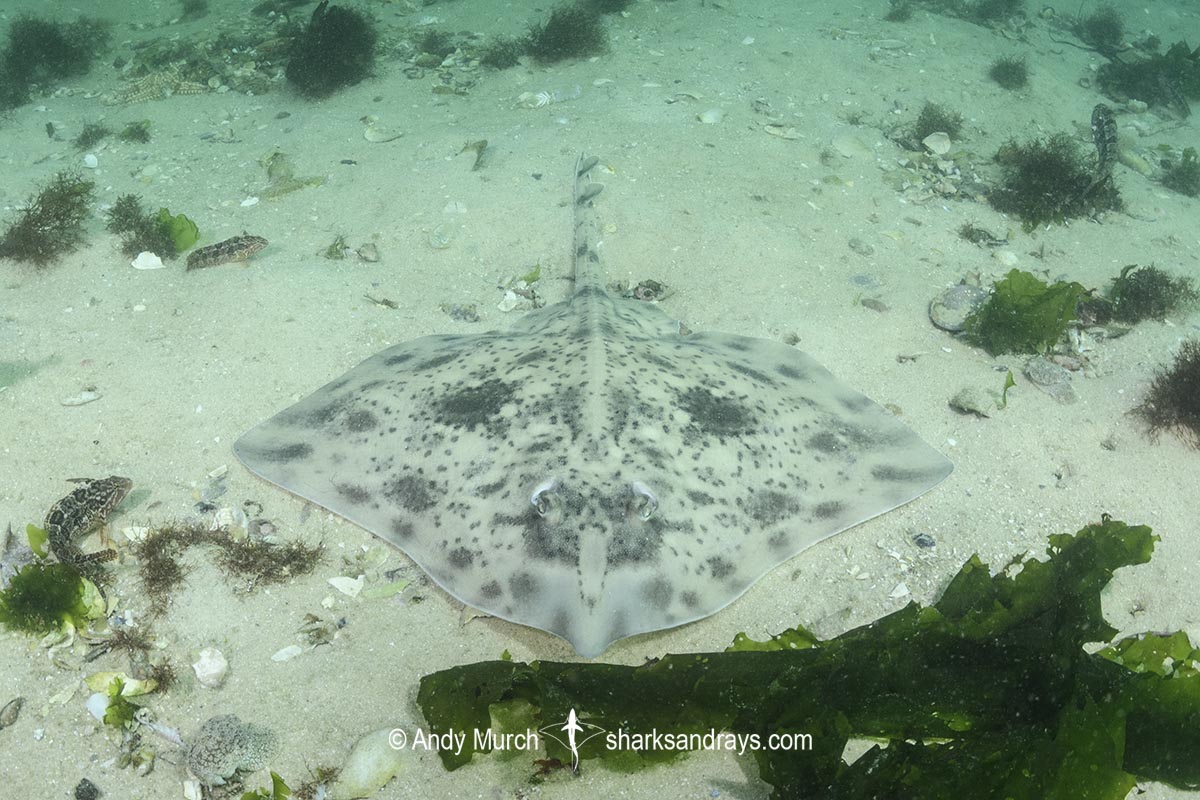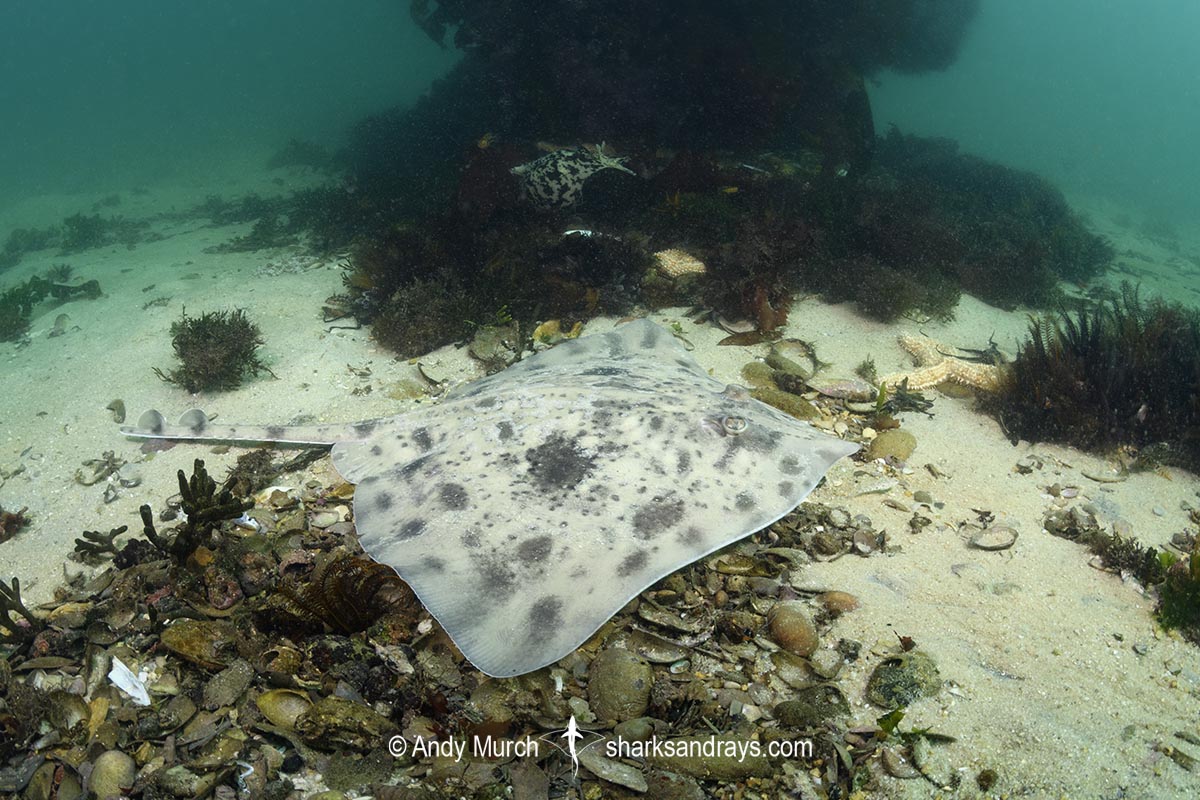Common name(s)
Biscuit Skate, Spotted Skate.
Identification
A fairly large skate with a broad, kite-shaped disc. Disc width 1.2-1.4 x disc length. Snout moderately long (2x inter-orbital space) outer angle obtuse, with a narrow, protruding tip. Eyes relatively large. Anterior margins of pectoral fins almost straight or weakly undulate. Pectoral apices narrowly rounded.
Disc covered in small prickly thorns in juveniles. Small thorns sometimes present on nape and shoulders. Males and females have a row of thorns along midline and tail. Females also have lateral thorn rows. Pelvic fins relatively large, weakly notched. Tail narrow and moderately long. Dorsal fins well separated, with rounded margins. 1-2 interdorsal thorns.
Colour
Dorsum cream, grey or brownish-grey, with a variable pattern generally consisting of numerous small (pupil-sized) dark spots or flecks, and much larger dusky blotches. Blotches may form a variegated row around margin of disc. A large pair of primitive, dark occeli are sometimes present on pectoral fins. Tail mostly pale with a few spots and 4-5 paired blotches forming rudimentary bands. Dorsal fins greyish with pale posterior margins. Ventrum white with a dusky margin, and a few dark blotches centrally and around cloaca.
Size
Maximum length 91cm. Egg case length ~8cm.
Habitat
Temperate and subtropical seas. Demersal sand, mud, gravel, and mixed substrates. Occurs inshore, and on the continental shelf and slope. From 1-690m.
Distribution
The biscuit skate is found from Mauritania in West Africa to South Africa. Possibly also present in Madagascar and Mauritius.

Conservation Status
NEAR THREATENED
The Biscuit Skate (Raja straeleni) is taken as bycatch of trawl and longline fisheries and, similar to other skates in the region, is either retained for consumption or discarded.
Currently, there are a number of European and Chinese distant-water vessels using trawls and longlines to target demersal fish and shrimp species that reach the depth limit of this species, especially in the northern part of its range in Morocco, Mauritania, Senegal, The Gambia, and Guinea-Bissau. While species-specific data are not available, both increases (Morocco) and declines (Mauritania) in landings of combined skates and rays have been documented in the northern portion of its range. However, little information is available on fishing pressure throughout the rest of its range, south through the Gulf of Guinea. In this region, the sea floor is reported to be not trawlable at depths of 75–200 m and demersal stocks in these waters therefore reportedly remain unexploited which might provide a refuge for this species from trawl fisheries throughout the central parts of its range.
Further information is urgently needed to determine the level of impact on this species, particularly as deep-water fisheries are expanding in response to declining fish stocks in heavily exploited coastal areas. However, species-specific population trend data from relative abundance in South Africa revealed no major population reductions over the past three generation lengths (21 years). Skate species, including the Biscuit Skate, are susceptible to overfishing due to their relatively low biological productivity, which is of concern for the Biscuit Skate. However, this species is likely to have refuge from fishing pressure across some of its core distribution and range. Yet, considering the level of intense and large unmanaged fisheries that operate throughout its northern range, and noted declines in landings of rays across its range, it is suspected that the Biscuit Skate has undergone a population reduction of 20–29% over the past three generation lengths (21 years) due to levels of exploitation in parts of its range and it is assessed as Near Threatened; close to meeting Vulnerable.
Citation
Jabado, R.W., Chartrain, E., Da Silva, C., De Bruyne, G., Derrick, D., Dia, M., Diop, M., Doherty, P., Leurs, G.H.L., Metcalfe, K., Pacoureau, N., Seidu, I., Soares, A.-L., Tamo, A., VanderWright, W.J., Williams, A.B. & Winker, H. 2021. Raja straeleni. The IUCN Red List of Threatened Species 2021: e.T161586A124510972. https://dx.doi.org/10.2305/IUCN.UK.2021-2.RLTS.T161586A124510972.en. Accessed on 26 May 2022.
Reproduction
Oviparous. Poorly known.
Diet
Benthic invertebrates and fishes.
Behavior
Unknown.
Reaction to divers
Easy to approach. Remains motionless unless harassed. Easily followed with non-threatening movements.
Diving logistics
The biscuit skate is rarely encountered at the northern end of its range, but it is sometimes seen in shallow bays in South Africa. Multiple sightings have occurred in False Bay, specifically, off Long Beach in Simonstown. Conducting a search over the sand in 10m depth, may yield results, but sightings are far from common.
What’s new
View our full list of updates
Similar species
Thornback Skate Disc sometimes similarly patterned, but distinguishable by heavily variegated/banded tail.













